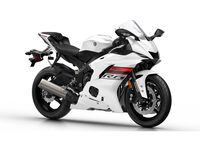Hybrid automobiles exist for one reason only: They are a useful tool in helping a manufacturer achieve government-imposed fuel-economy standards. Corporate Average Fuel Economy standards allow an automaker to sell profitable but fuel-hungry models legally and without penalty if they also manufacture a sufficient number of highly fuel-economical models. It is the average fuel economy of the maker’s entire production that is regulated.
No such government fuel-economy standards have yet been applied to new motorcycles, so there is no pressure to improve their fuel economy and so no reason to consider building hybrid motorcycles.
There are, on the other hand, good reasons not to build hybrid motorcycles. First among them is increased cost, which in a time of depressed new motorcycle sales would be just another reason not to buy or to prefer a used bike. A second reason is that motorcycles already have “high solidity”—their volume is full. Where would you locate a hybrid’s electric traction motor, its power supply, and a battery capable of driving it a useful distance?
Toyota’s Prius is America’s best-known hybrid. Its 1,800cc gasoline engine is about twice the displacement of common bike engines, and its plug-in version’s 8.8 kWh lithium-ion battery weighs 265 pounds while the car weighs 3,365 pounds. Suppose we proportion a notional motorcycle hybrid battery to engine displacement. A battery half the weight of that used in a Prius would be like carrying an extra passenger on your bike, and it leaves out the weight of the power supply, electric traction motor, and associated details. Okay, let’s instead size the battery in proportion to vehicle weight plus one operator. Our 425-pound motorcycle and 175-pound rider total 600 pounds, while Prius plus driver equals 3,365 + 175 = 3,540 pounds or roughly six times as much. That might imply a much lighter battery of 265/6 = 44 pounds, plus more for motor and power supply, likely a total of at least 100 pounds. Still a lot of extra weight. And cost.
The hybrid “premium” is how much more a hybrid costs than a conventional single-engined model of equal bling level. A quick look around suggests that adding hybrid capability boosts price about one-third. That suggests a hybrid Yamaha YZF-R6 might weigh at least 520 pounds (instead of its actual as-tested 419) and cost roughly $16,000 instead of its present $12,199. Interested?
If governments decide in future to regulate motorcycle fuel consumption, there are less heavy and less expensive ways to improve mileage. First among them would be to reduce engine rpm (and therefore friction loss) by doing what the auto industry does: providing more transmission speeds so the engine can spend more time near its lower rpm/larger throttle angle “island of least fuel consumption.” My wife’s horse-trailer tow vehicle goes up the interstate at 1,700 rpm but the R6 has to spin four times faster. That generates a lot of engine friction. An overdrive seventh gearbox speed could pull that cruise rpm down, and fuel consumption would fall with it. And if you’re really earnest about saving the planet, there’s public transportation; 50 commuters in a bus burn a lot less fuel than 50 commuters in 50 cars or even on 50 motorcycles. Or you could work from home.
Another path to economy is to use smaller, lower-friction engines and recover adequate on-ramp acceleration with supercharging or turbocharging. Many an automaker is using this method right now; think of the fair-sized SUVs now powered by dinky turbo engines close to two liters in displacement. Those smaller engines are in there because CAFE requires their better fuel economy.
When it comes to serious fuel economy, have a look at the radically streamlined motorcycles that imaginative veteran designer Craig Vetter builds. Almost 40 years ago, he built one powered by a 20-hp Kawasaki four-stroke single that gave 108 mpg at highway speed. Motorcycles, even those with fairings, generate a lot of drag because their chopped-off shapes pull behind them a mass of energy-sapping turbulence. Vetter prevents this by giving his designs a fish-like low-drag shape.
“Yeah, but if I have to ride a no-fun 20-hp bike that looks like a fish, I’ll take the bus,” some might reply. Right now, we don’t face such decisions. And I recall that back in the days of the 50cc—that’s 3ci—Grand Prix roadracing class, top speeds were in the 120-mph range. Could it be that motorcycles, large or small, are just inherently a lot of fun?













/cloudfront-us-east-1.images.arcpublishing.com/octane/REUHOJXRDBGZ5IHBYZCCBCISPA.jpg)
/cloudfront-us-east-1.images.arcpublishing.com/octane/52LGJTCKBFEHDF7S7H4CVUIMGM.jpg)
/cloudfront-us-east-1.images.arcpublishing.com/octane/YMWAIPIPSJAOXOU3QMJMGH37OM.jpg)


/cloudfront-us-east-1.images.arcpublishing.com/octane/EJ6KZRGAYBCVXNL2PJXL37UVWQ.jpg)
/cloudfront-us-east-1.images.arcpublishing.com/octane/AAN4TI76M5H5JMUVEIGASWXBDU.jpg)
/cloudfront-us-east-1.images.arcpublishing.com/octane/P3RXD2UCPFF37CMB7CHPVKXORY.jpg)
/cloudfront-us-east-1.images.arcpublishing.com/octane/VZEG2EJI2RDFZNHLRZMU56MD3Q.jpg)
/cloudfront-us-east-1.images.arcpublishing.com/octane/GVJQO5FFOFBWNGODOBRB4FBAW4.jpg)
/cloudfront-us-east-1.images.arcpublishing.com/octane/BIVAK2SFIBDJJM25E7I5VU2FJE.jpg)
/cloudfront-us-east-1.images.arcpublishing.com/octane/CH5VX52UG5CFHOVH5A6UYEFWWA.jpg)
/cloudfront-us-east-1.images.arcpublishing.com/octane/ZVGJNGZRU5C33N7KN23BBFKSC4.jpg)


/cloudfront-us-east-1.images.arcpublishing.com/octane/CZ5OM3E43ZEXJHY7LCYXCHLIKI.jpg)
/cloudfront-us-east-1.images.arcpublishing.com/octane/DF5T4K5KPZFJXFCTGPYR77PKJM.jpg)
/cloudfront-us-east-1.images.arcpublishing.com/octane/RMCT2KVQBJHBZMRTSLOVPMOILU.jpg)

/cloudfront-us-east-1.images.arcpublishing.com/octane/K45KB2XHQVA65DX7VN4ZSMT2BI.jpg)
/cloudfront-us-east-1.images.arcpublishing.com/octane/FNHXQQ56BRD7TO4YIJ453PNG2M.jpg)
/cloudfront-us-east-1.images.arcpublishing.com/octane/OIKJC4JA3ZH7BMKUGWYKBIY5FA.jpg)
/cloudfront-us-east-1.images.arcpublishing.com/octane/MT2SAEWY6FDXFBYSLDE3AEFDTM.jpg)
/cloudfront-us-east-1.images.arcpublishing.com/octane/66UPKPYVURBPRCP5HXSN56MEMM.jpg)